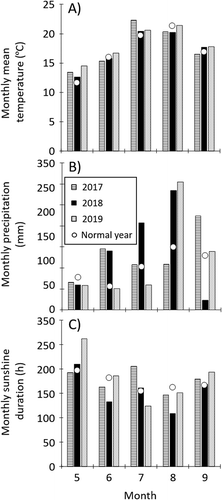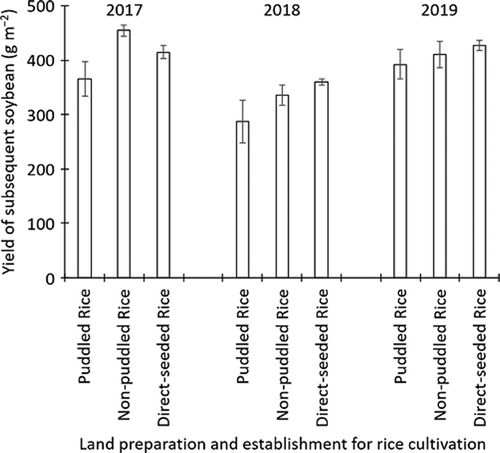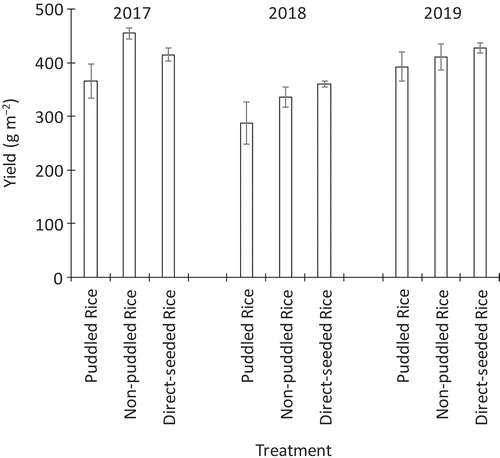ABSTRACT
Non-puddling rice cultivation would increase subsequent soybean yield. Soybean (cv. ‘Yukihomare’) was grown in farmers’ fields previously cultivated with puddled transplanted rice (Puddled Rice), non-puddled transplanted rice (Non-puddled Rice), and dry direct-seeded rice (Direct-seeded Rice) in central Hokkaido, Japan. Average soybean yield was significantly (p < 0.05) higher in Non-puddled Rice fields (411 g m−2) and in Direct-seeded Rice fields (404 g m−2) than in Puddled Rice fields (352 g m−2). The respective yield increases (16.8% and 14.7%) indicate that non-puddling rice cultivation increased subsequent soybean yield. The significantly higher values for shoot dry weight and number of seeds per m2 seen in fields after non-puddling rice cultivation suggest that non-optimal plant development during vegetative and early reproductive growth stages may be ameliorated. The increases in soybean yield seen in this study may encourage the adoption of non-puddling rice production under the rice–soybean rotation system in Japan.
Introduction
Soybean (Glycine max (L.) Merr.) is an important crop for food, oil, and protein. To meet the future predicted demand for soybeans, production needs to be increased (Kawasaki et al., Citation2016). Soybean has long been used in the traditional cuisine of Japan, ‘Washoku’, and in foods such as tofu, miso, nattō, and soy source (Matsuo et al., Citation2018). Soybean production per unit area (yield) in Japan has not improved in the past 30 years (1988–2017); it has fluctuated between 1.1 and 2.0 t ha−1 (averaging 1.6 t ha−1), while the world average yield has steadily increased from 1.7 t ha−1 in 1988 to 2.8 t ha−1 in 2017 (FAO, Citation2019). Most of the areas (>80%) dedicated to soybean production in Japan are under a paddy-upland (rice–soybean) rotation system (Ministry of Agriculture, Forestry and Fisheries, Citation2019a). Consequently, if total soybean production in Japan is to be increased, improvements in soybean yield under the current system are necessary.
The generally established method of planting lowland rice in paddy fields is by transplantation in tilled and puddled fields. Although puddling offers advantages in weed control and prevention of water leakage (Kondoh et al., Citation2019), leading to stable rice cultivation, this conventional practice is labor-, water-, capital-, and energy-intensive, and it is becoming less profitable as these resources are becoming increasingly scarce (Chakraborty et al., Citation2017). Omitting puddling can reduce labor and fuel costs, and irrigation water input, for land preparation for rice establishment (Hossen et al., Citation2018). Furthermore, direct seeding eliminates the necessity of raising seedlings and transplanting those (Okamura et al., Citation2018). However, there have been no reports to date on the effects of non-puddled rice cultivation on subsequent soybean yield under the rice–soybean rotation system used in Japan. Under rice–wheat rotation systems in south Asia, wheat yield is higher when it is grown after dry direct-seeded rice in non-puddled fields than when grown after conventional puddled transplanted rice (Kumar & Ladha, Citation2011). Thus, we hypothesized that non-puddling rice cultivation would increase subsequent soybean yield under the rice–soybean rotation system in Japan.
Hokkaido is the largest soybean-growing region in Japan, accounting for >35% of production (Ministry of Agriculture, Forestry and Fisheries, Citation2019b). Although soybean has been cultivated mainly under continuous upland conditions in Hokkaido, the area of soybean production under the rice–soybean rotation system has steadily increased in recent years to 47% in 2018 (Ministry of Agriculture, Forestry and Fisheries, Citation2019b). We, therefore, undertook on-site investigations in farmers’ fields in Hokkaido, Japan for three consecutive years to test our hypothesis.
Materials and methods
In 2017, 2018, and 2019, field surveys were conducted at Iwamizawa City, central Hokkaido in 16, 13, and 18 farmers’ fields, respectively. The criteria for selecting fields were only land preparation (puddled or non-puddled) and crop establishment (transplanting or direct-seeding) in rice cultivation in the previous year of soybean cultivation. The number of farmers who participated in this study was 21 and we refer to them as farmer A–U. Soybean (cv. ‘Yukihomare’) was cultivated in fields which had previously been cultivated with puddled transplanted rice (Puddled Rice), non-puddled transplanted rice (Non-puddled Rice), or dry direct-seeded rice in non-puddled soil (Direct-seeded Rice). The numbers of fields allocated to each treatment and the reference of farmers in charge are shown in . Sowing dates were from mid-May to late May in all years. Fertilizer application and weed, insect, and pest controls were performed as needed based on each farmer’s decision. Questionnaires were distributed among the farmers in charge after the end of cultivation. The soybean cultivation conditions among the treatments were not necessarily similar due to differences among the farmers in charge ().
Table 1. The number of fields allocated to three treatments, soybean cultivation after puddled transplanted rice (Puddled Rice), non-puddled transplanted rice (Non-puddled Rice), and dry direct-seeded rice in non-puddled soil (Direct-seeded Rice) and the farmers in charge out of 21 farmers (referred to as Farmer A–U) who participated in this study
Table 2. Number of fields that received the same operation in each work content for soybean cultivation and their breakdown among treatments (Puddled Rice, Non-puddled Rice, and Direct-seeded Rice) according to questionnaires distributed among farmers in charge
Yield and yield-related parameters for each field were determined as an average from three locations within a field, each measuring 2.376 m2 (two 1.8 m rows with 0.66 m interval). The harvest was conducted in late September in all years. The plants were cut manually at the soil surface. Yield and 100-seed weight were determined using seeds of marketable quality (adjusted to a 15% moisture content). Meteorological data were obtained from the closest Automated Meteorological Data Acquisition System station (Iwamizawa WMO station, 43°12.7′ N, 141°47.1′ E) of the Japan Meteorological Agency.
The statistical package R (Version 3.5.4) (R Core Team, Citation2019) was used for the statistical analysis. Two-way analysis of variance was performed using the built-in aov function to identify significant effects of year, treatment, and their interaction on yield and yield-related parameters. Average values were compared among years and treatments used Tukey’s honest significant difference (HSD) test with the built-in TukeyHSD function.
Results and discussion
Monthly mean temperature, precipitation, and sunshine duration from May to September in 2017, 2018, 2019, and the 30-year mean are shown in . The temperature in 2019 from May to September (14.5–21.4°C) tended to be higher than that in 2017 and 2018 (13.4–22.3°C and 12.6–20.4°C, respectively). The mean precipitation for the five months in 2018 (143 mm) was higher than in 2017 and 2019 (130 and 122 mm, respectively), with precipitation particularly high from June to August 2018. The sunshine duration in June and August 2018 (133 and 109 h, respectively) was markedly shorter, and the mean value for the five months in 2018 (156 h) was shorter than those in 2017 and 2019 (178 and 184 h, respectively). In other words, 2018 was a year of high precipitation and low sunshine.
Figure 1. Monthly mean temperature, precipitation, and sunshine duration from May to September in the three years and the 30-year mean (1981–2010)

Soybean yields were at least 367, 288, and 393 g m−2 in 2017, 2018, and 2019, respectively, irrespective of treatment (). The yields in 2017 and 2018 were much higher than the average yield in Iwamizawa city (287 and 224 g m−2 in 2017 and 2018, respectively) (Hokkaido District Agriculture Office, Citation2019, Citation2020), although a simple comparison between the yields estimated from small-area sampling and those calculated for the whole city may be inconclusive (at the time of writing, the average yield for the city in 2019 was not available). The relatively high yields in this study suggest that all the farmers who participated in this study were well experienced. The effect of year was significant (p < 0.05) on yield and all the yield-related parameters, except for the number of plants per m2. The effect of treatment was significant (p < 0.05) on yield, the number of seeds per m2, and shoot dry weight. The year × treatment interaction had no significant effect on any of the parameters (). Thus, the averages of year and treatments were compared.
Table 3. Effects of year, treatment and their interaction on soybean yield and yield-related parameters, according to two-way analysis of variance
The soybean yield and yield-related parameters, except the number of seeds per pod, were lower in 2018 than in 2017 and 2019 (). The low yield in 2018 can be attributed to the high precipitation and short sunshine duration during the cultivation period. It is widely accepted that excess water, especially in the first half of the growing period, leads to stress that inhibits soybean growth (Kumagai, Citation2018). Nevertheless, even when 2018 (which showed unsuitable weather conditions for high yield of soybean) is included, across the three years the yield was significantly (p < 0.05) higher in the fields after the cultivation of Non-puddled Rice (411 g m−2) and Direct-seeded Rice (404 g m−2) than in the fields after cultivation of Puddled Rice (352 g m−2) (). These results confirm our hypothesis that non-puddling rice cultivation increases yield in a subsequently planted crop of soybean, irrespective of year and method of rice establishment (transplantation or direct seeding). It is noteworthy that the effect of non-puddling rice cultivation was evident in the farmers’ fields, even though the conditions of soybean cultivation were different in each field. This effect may be strong enough to be confirmed even though the soybean growth conditions, which depend on the farmers in charge, were different. However, other than the presence or absence of puddling, there might be factors influencing the increase in soybean yield in the fields selected for Non-puddled Rice and Direct-seeded Rice treatments.
Table 4. Average soybean yield and yield-related parameters in each year and treatment
The knowledge that soybean yield could be increased by omitting puddling during preceding rice cultivation would likely stimulate an increase in the use of non-puddling rice production under the rice–soybean rotation system used in Japan. In addition, the Non-puddled Rice and Direct-seeded Rice techniques are more environmentally friendly, since puddling involves the release of muddy puddling water that causes a large pollution load (Harada et al., Citation2008). Although non-puddling rice cultivation has risks, including reduced planting accuracy of rice, increased water leakage from the field, and the potential need for significant adjustment of soil water conditions before tillage (Kondoh et al., Citation2019), the technique may be worth adopting under the rice–soybean rotation system.
Further research is needed to elucidate the mechanisms underlying the higher soybean yield in the fields after the cultivation of Non-puddled Rice and Direct-seeded Rice than in those after cultivation of Puddled Rice. Soybean shoot dry weights were significantly (p < 0.05) higher in the former than in the latter. Additionally, omitting puddling during preceding rice cultivation significantly (p < 0.05) increased the number of soybean seeds per m2, particularly in the fields after cultivation of Non-puddled Rice. Furthermore, the number of soybean plants per m2 tended to be higher in the fields after cultivation of Non-puddled Rice and Direct-seeded Rice than in the fields after cultivation of Puddled Rice (). These findings suggest that soybean development during the vegetative and early reproductive growth stages is ameliorated in the fields after cultivation of Non-puddled Rice and Direct-seeded Rice. Poor stand establishment due to low germination rates of subsequent upland crops has been linked to inadequate seed-soil contact in cloddy soil in post-paddy fields (Farooq et al., Citation2008). In addition, nonoptimal plant development during late seed filling (after pod and seed number is fixed) is a factor that affects the growth of the developing seed and ultimately the seed size (Egli & Bruening, Citation2004). Therefore, the tendency for soybean 100-seed weight to be heavier in the fields after cultivation of Non-puddled Rice and Direct-seeded Rice than in the fields after cultivation of Puddled rice () suggests that the omission of puddling during preceding rice cultivation improves soybean growth during late seed filling periods.
Puddling may adversely affect the growth and yield of subsequent upland crops because of its adverse effects on soil physical properties, which include destroying soil aggregates, reducing permeability and forming hard-pans, and accompanying limited root growth (Chakraborty et al., Citation2017; Kumar & Ladha, Citation2011). In rice-wheat system, the adverse effects of puddling on wheat yield were significant even after four rounds of tillage and two planking for land preparation for wheat (Farooq et al., Citation2008). In the current study, the number of tillage rounds for soybean cultivation was often four or less (). Changes in soil physical properties may lead to changes in soil chemical properties. Furthermore, symbiotic microbes would affect soybean growth and yield; thus, any effects of non-puddled rice cultivation on nodulation and infection by arbuscular mycorrhizal fungi in subsequent soybean crops should be examined.
It should be noted that the yield differences among treatments were smaller in 2019 than in the other two years (). The effects of omitting puddling on soybean yield probably depend on the growth conditions of each case. For example, 2019 had less precipitation in June and July than 2017 and 2018 did, indicating that the adverse effects on soybean growth due to excess water in the first half of the growing period were less in 2019 than in the other two years (). Such weather conditions in 2019 may mitigate the adverse effects of puddling on soybean growth and yield. Furthermore, the degree of soybean yield increase in revenue from omitting puddling may depend on growth conditions specific to each field. Studies from these perspectives will be reported in the future.
Acknowledgments
We would like to thank Mr. S. Suda in JA Iwamizawa and farmers at Iwamizawa city for full cooperation in the on-site investigation. The authors are indebted to Ms. E. Fujiwara, Ms. M. Aoyama, Ms. N. Haga, Mr. S. Suzuki, Mr. T. Ban, Mr. T. Maeda, Mr. T. Takemoto, Ms. Y. Fukumi, Mr. Y. Yokochi in Hokkaido Agricultural Research Center, NARO, for their technical assistance.
Disclosure statement
No potential conflict of interest was reported by the authors.
Additional information
Funding
References
- Chakraborty, D., Ladha, J. K., Rana, D. S., Jat, M. L., Gathala, M. K., Yadav, S., Rao, A. N., Ramesha, M. S., & Raman, A. (2017). A global analysis of alternative tillage and crop establishment practices for economically and environmentally efficient rice production. Scientific Reports, 7(1), 9342. https://doi.org/10.1038/s41598-017-09742-9
- Egli, D. B., & Bruening, W. P. (2004). Water stress, photosynthesis, seed sucrose levels and seed growth in soybean. Journal of Agricultural Science, 142(1), 1–8. https://doi.org/10.1017/S0021859604004095
- FAO. (2019). FAOSTAT.
- Farooq, M., Basra, S. M. A., & Asad, S. A. (2008). Comparison of conventional puddling and dry tillage in rice–wheat system. Paddy and Water Environment, 6(4), 397–404. https://doi.org/10.1007/s10333-008-0138-6
- Harada, H., Ota, T., Shindo, H., Kobayashi, H., & Ito, C. (2008). Estimations and characteristics of water pollutant load from large scale paddy fields in Hachirogata Polder. Japanese Journal of Soil Science and Plant Nutrition, 79(1) (in Japanese with English abstract), 53–60. https://doi.org/10.20710/dojo.79.1_53
- Hokkaido District Agriculture Office. (2019). Hokkaido agriculture, forestry and fisheries statistics annual report. Ministry of Agriculture, Forestry and Fisheries of Japan. https://www.maff.go.jp/hokkaido/toukei/kikaku/nenpou/28-29sougou/attach/pdf/28-29sougou-132.pdf (in Japanese)
- Hokkaido District Agriculture Office. (2020). Hokkaido agriculture, forestry and fisheries statistics annual report. Ministry of Agriculture, Forestry and Fisheries of Japan. https://www.maff.go.jp/hokkaido/toukei/kikaku/nenpou/29-30sougou/attach/pdf/29-30sougou-97.pdf (in Japanese)
- Hossen, M. A., Hossain, M. M., Haque, M. E., & Bell, R. W. (2018). Transplanting into non-puddled soils with a small-scale mechanical transplanter reduced fuel, labour and irrigation water requirements for rice (Oryza sativa L.) establishment and increased yield. Field Crops Research, 225, 141–151. https://doi.org/10.1016/j.fcr.2018.06.009
- Kawasaki, Y., Tanaka, Y., Katsura, K., Purcell, L. C., & Shiraiwa, T. (2016). Yield and dry matter productivity of Japanese and US soybean cultivars. Plant Production Science, 19(2), 257–266. https://doi.org/10.1080/1343943X.2015.1133235
- Kondoh, T., Nagasaka, Y., Kato, A., Shindo, H., Kato, M., Saito, M., Fujiwara, K., Yamamoto, S., & Yaji, Y. (2019). Reduction of nitrogen, phosphorus, and suspended solids effluent loads from paddy fields by transplanting into retained ponding water using a GNSS-controlled rice transplanter. Paddy and Water Environment, 17(2), 221–230. https://doi.org/10.1007/s10333-019-00714-5
- Kumagai, E. (2018). Effect of early sowing on growth and yield of determinate and indeterminate soybean (Glycine max (L.) Merr.) cultivars in a cool region of northern Japan. Journal of Agricultural Meteorology, 74(1), 18–28. https://doi.org/10.2480/agrmet.D-17-00009
- Kumar, V., & Ladha, J. K. (2011). Direct seeding of rice: Recent development and future research needs. Advances in Agronomy, 111, 297–413. https://doi.org/10.1016/B978-0-12-387689-8.00001-1
- Matsuo, N., Yamada, T., Takada, Y., Fukami, K., & Hajika, M. (2018). Effect of plant density on growth and yield of new soybean genotypes grown under early planting condition in southwestern Japan. Plant Production Science, 21(1), 16–25. https://doi.org/10.1080/1343943X.2018.1432981
- Ministry of Agriculture, Forestry and Fisheries. (2019a). Data collection related to soybean.Ministry of Agriculture, Forestry and Fisheries of Japan. http://www.maff.go.jp/j/seisan/ryutu/daizu/d_data/attach/pdf/index-36.pdf (in Japanese)
- Ministry of Agriculture, Forestry and Fisheries. (2019b). Data collection related to soybean. Ministry of Agriculture, Forestry and Fisheries of Japan. http://www.maff.go.jp/j/seisan/ryutu/daizu/d_data/attach/pdf/index-39.pdf (in Japanese)
- Okamura, N., Yasumoto, S., Kojima, M., Okamura, M., & Ohshita, Y. (2018). Establishment rate of direct-seeded rice in the relay-intercropping system in Kanto region of Japan. Plant Production Science, 21(3), 278–285. https://doi.org/10.1080/1343943X.2018.1486215
- R Core Team. (2019). R: A language and environment for statistical computing. R Foundation for Statistical Computing, Vienna, Austria. https://www.R-project.org/

